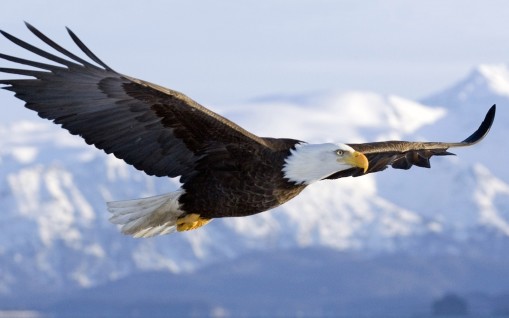The American bald eagle (Haliaeetus Leucocephalus) was adopted as the official bird emblem of the United States of America in 1782. The bald eagle was chosen because of it’s majestic beauty, great strength, long life, and because it’s native to North America. In the wild, an eagle will live 30-35 years (up to 50 years in captivity). A full-grown bald eagle has a wingspan up to 7 feet. They fly up to 30 miles an hour and can dive at 100 miles an hour! Eagles feed primarily on fish, supplemented by small mammals, waterfowl, and carrion.
Eagles mate for life, and an established pair will use the same nest for many years. Over time some nests become enormous – they can reach a diameter of 9 feet and weigh as much as 2 tons! The female lays 2 or 3 eggs and both parents share incubation and guard them diligently against predators (such as squirrels, gulls and ravens). While the chicks are small, the parents move about the nest with their talons balled up into fists to avoid harming them.
***
In 1782 there were between 25,000 and 75,000 birds in the lower 48 states alone. But farmers considered bald eagles vermin and shot them on sight. As people started moving west, much of the nesting territories and food sources of the eagle diminished. By the late 1800’s, eagles were becoming very scarce.
In 1940 the Bald Eagle Act was passed and eagle populations began to recover. But pesticides were starting to be used extensively about this same time. Plants sprayed with DDT were eaten by small animals, which in turn were eaten by eagles. Both the adult birds and their eggs were affected. The eggshells were too thin to withstand incubation and were crushed (or simply did not hatch). Large quantities of DDT were found in the fatty tissues of dead eagles, and by 1963 their numbers had fallen to a mere 417 nesting pairs.
The Endangered Species Acts of 1966 and 1978 helped to protect the bird, but banning of DDT in 1972 was the most effective in the bald eagle’s recovery. By the year 2000 the US Fish & Wildlife Service proposed that the eagle be declared fully recovered, but as no plan to manage the species exists, it is still listed as threatened.
***
Read more >>> 7 Highly Effective Habits of Eagles





Hello , I just wanted to say thank you for dropping in and following me I shall enjoy having a look around your blog which I must say is stunning!!
LikeLiked by 1 person
Thank you so much dear 🙂
Many Thanks for visiting our blog and for your feedback. Life is not always easy but at least we can learn something from the eagles. Be in touch. Browse through the category sections, We truly feel you may find something of your interest.
LikeLiked by 1 person
Thank you so much I will . I do love eagles and crows and all their their breathern. They do have a lot to teah us. 😉
LikeLiked by 1 person
Thank you pgcpsmess for joining up with us it is appreciated did you see our Eagle?
Wow! I can’t wait to roam your Blog and read all about the eagles, thank you so mush for sharing about them and the wonderful pictures too. God’s creation is amazing.
Blessings – Anne
LikeLiked by 1 person
Pingback: Eagle in flight…. | pgcps mess - Reform Sasscer without delay.
Pingback: Eagle in flight…. | Help Change The World. The Future Of The County Is Now.
How interesting. It’s a disgrace that there is nothing in place to protect the species. Thanks so much for following First Night Design.
LikeLike
Thank you for the follow! What an amazing post, the sheer majesty of the Bald Eagle is humbling. Your blog is fulfilling an important function, educating us about birdlife and nature.
LikeLiked by 1 person
Oh thank you. Very kind of you to say that 🙂 You make me feel encouraged. It’s good to know that people value this work. Many thanks for following our blog as well and let us stay connected. Happy Holidays!
LikeLike
Amazing shots! On Vancouver Island, they are everywhere.
LikeLiked by 1 person
The bald eagle is a fantastic bird! So are your pictures of it!
Thanks for subscribing to my blog! Here you’ll find more than 3500 pictures from Norway and Norwegian nature, mostly in ‘full screen mode’, and new pictures will be posted on a regular basis! However, it’s going to be less than normal during the winter season.
Please enjoy! And if you really like our pictures, please tell your friends!
LikeLike
Reblogged this on Hey Sweetheart, Get Me Rewrite! and commented:
WELCOME TO A NEW FRIEND
LikeLike
Thanks. Very interesting blog with brilliant photographic illustration. More visits to come! Regards from Thom at the immortal jukebox.
LikeLike
Pingback: Eagle Gets Shot In The Face Then Gets New Life! | Positive Truth – Manifest Your Destiny
Hey what fantastic pics you have of eagles on here! Would you mind if I use one on my facebook page as a profile pic?
LikeLike
Sure
LikeLike